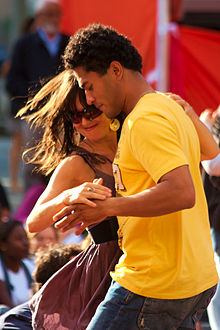Merengue (dance)
 |
|
| Genre | Latin American dance |
|---|---|
| Time signature | 4/4 |
| Origin | Dominican Republic |
Merengue (/məˈrɛŋɡeɪ/,Spanish: [meˈɾeŋɡe]) is a style of Dominican music and dance. Partners hold each other in a closed position. The leader holds the follower's waist with the leader's right hand, while holding the follower's right hand with the leader's left hand at the follower's eye level. Partners bend their knees slightly left and right, thus making the hips move left and right. The hips of the leader and follower move in the same direction throughout the song. Partners may walk sideways or circle each other, in small steps. They can switch to an open position and do separate turns without letting go each other's hands or releasing one hand. During these turns they may twist and tie their handhold into intricate pretzels. Other choreographies are possible.
Although the tempo of the music may be frenetic, the upper body is kept majestic and turns are slow, typically four beats/steps per complete turn.
In the social dancing of the United States the "empalizada" style is replaced by exaggerated Cuban motion, taught in chain ballroom studios for dances of Latin American origin (cha-cha-cha, rumba, mambo, salsa).
Merengue was made the official music of the Dominican Republic by Rafael Trujillo. In one version, the dance originated from the enslaved laborers working in sugar beet fields. These workers were connected to one another by a chain strapped to their ankles and had to walk in such a manner as to drag one leg.
...
Wikipedia
